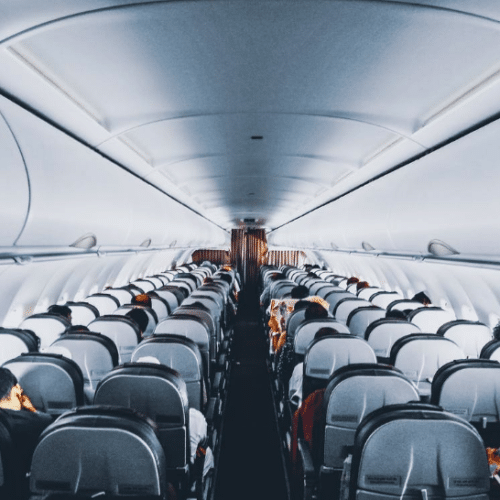Summer is here and under normal circumstances, this would be a big travel season. We’d usually be shoulder-to-shoulder with fellow passengers in TSA lines and sitting closely together on planes all in the pursuit of traveling somewhere new {or familiar} for a summer vacation.
This year, as the COVID-19 pandemic impacts every aspect of our life, air travel, like many other “ordinary things” has also been put on pause and become another source of frustration and anxiety. Yes, it does sound risky to travel right now — studies have shown that the virus spreads most easily among large groups in enclosed spaces, which is essentially all an airplane is. Still, as countries and states start to lift stay-at-home orders, there is likely to be an increase in both essential and non-essential air travel. For those who are curious about what it is like to fly during the pandemic and how to stay safe during a flight, below is a first-person experience based on a flight Yiwei, a Team HG contributor recently took, as well as a list of personal safety measures to take recommended by doctors.
Disclaimer: This article is for informational purposes only as it is an individual, first-hand account. If you have any concerns about air travel or health, please contact your travel and/or healthcare provider directly.
Inside the Airport
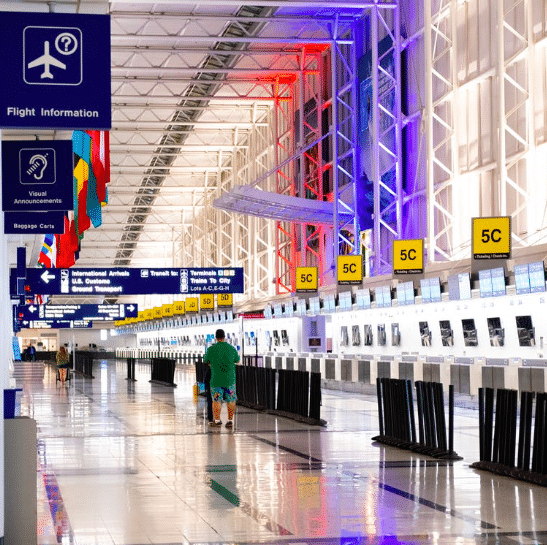
Many of us are fond of indulging in a pre-flight meal or beverage but due to COVID-19, things are a bit different. I observed that airport shops and kiosks were mostly closed or operating at reduced capacity, and water fountains were shut off. In both airports I visited, those who wished to buy any type of food or drink would need to wait in {extremely} long lines in front of the only one or two short-staffed coffee stands that remained open. Some passengers had to regretfully leave the line when they heard the final boarding calls of their flights. However, as businesses reopen in the upcoming weeks, hopefully, more airport shops will reopen and this situation may at least partially get resolved.
Aside from the amenities, airports have done their parts in keeping travelers safe as far as the basics go. I also observed that employees all had their masks on and it was easy to find hand sanitizer dispensers. There were also signs and airport broadcasts reminding people to keep six feet apart from each other. And given that the crowd was much thinner than normal times, the areas normally prone to congestions, such as taxi areas and security checks, were largely stress-free. Also, since air traffic has been slashed amid the global lockdown, planes rarely have to wait long on the tarmac for a spot to take off or land.
What It’s Like on The Plane
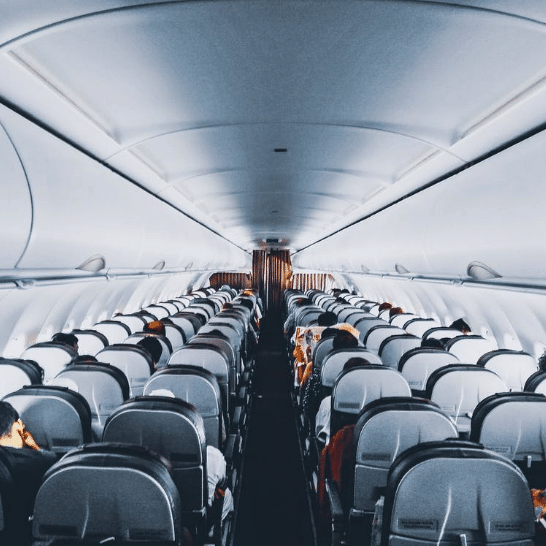
I took these flights back in late May. It was a round trip to Savannah, Georgia with a domestic budget airline. The flights were short — two hours each way.
I noticed that the planes were full of passengers on both of my flights. Based on interviews with other travelers who have flown domestically in the past few weeks, full flights are not uncommon. Due to mass cancellations, travelers whose departure dates would have been more spread out were consolidated into only a few flights that were still operating. “I got canceled eight times over the past month,” a fellow flight passenger said to me during our flight. “My original flight was with another airline. It got pushed back several times before it was finally canceled. Then I bought another ticket with this airline, which also delayed the flight a few times until this one was confirmed.”
Flight cancellations can be an even bigger problem for those who need to fly abroad. Foreign students, who are planning trips home for the summer and potentially the fall semester if classes continue to take place online, have said that it is not uncommon to buy multiple tickets {the source I talked to bought seven, her roommate bought ten!} before finally securing a ticket back, given the constantly changing border control situations throughout the world recently.
See More: ‘It Felt Like Someone Had Locked Up My Lungs:’ A COVID-19 Patient Shares Their Story
Precautions on the Flight
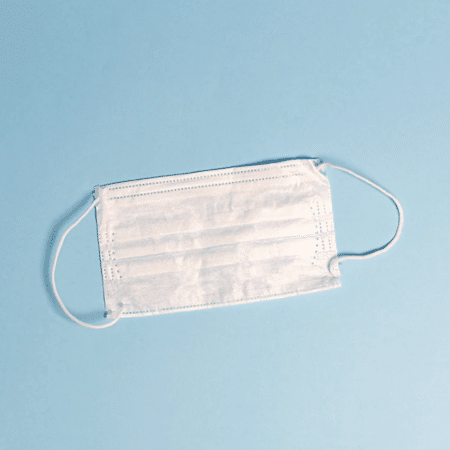
Fortunately, all major U.S. airlines, this one included, now require employees and passengers to wear masks during flights. On my flight, if a passenger got on the plane with his or her face uncovered, a flight attendant would hand him or her a surgical mask at the entrance and ask the passenger to put it on. On this specific flight as well, the passengers were compliant — almost everyone wore face coverings by the time they boarded the plane, and most people kept their masks on during the entire flight.
Another piece of good news is that many airlines have stepped up their cleaning procedures of aircraft cabins {like this one}. Also, the high-efficiency particulate air {HEPA} filtration systems installed in most U.S. aircrafts are powerful in removing disease-causing bacteria and viruses. The CDC also confirms that “Most viruses and other germs do not spread easily on flights because of how air circulates and is filtered on airplanes.” Depending on the airline and the disease control policies of the destination, other safety measures, such as pre-boarding temperature checks, blocking middle seats, and limiting capacities may also be in place.
Of course, when traveling during a pandemic, it is hard to not be highly-aware of every sneeze, cough, and voice you hear. To minimize the likelihood of infection, epidemiologists also recommend having masks on for as long as possible and to refrain from eating and drinking on short flights.
Eating can be tricky for passengers of longer flights. Travelers who have recently taken long-haul flights {10 hours plus} have shared with HG stories of fellow passengers who refused to eat or drink anything the entire way and thus were so weakened from low blood sugar and dehydration that they needed to be carried off the plane when it landed. For long-haul flight passengers, doctors have recommended using hand sanitizer frequently and packing single-serve packaged food to avoid hand-mouth contacts. In fact, many airlines have already suspended in-flight services and have begun to serve single-serve snacks instead. Some doctors have also suggested eating at a different time from people nearby to avoid many people taking off their masks at the same time.
How to Stay Safe on a Flight
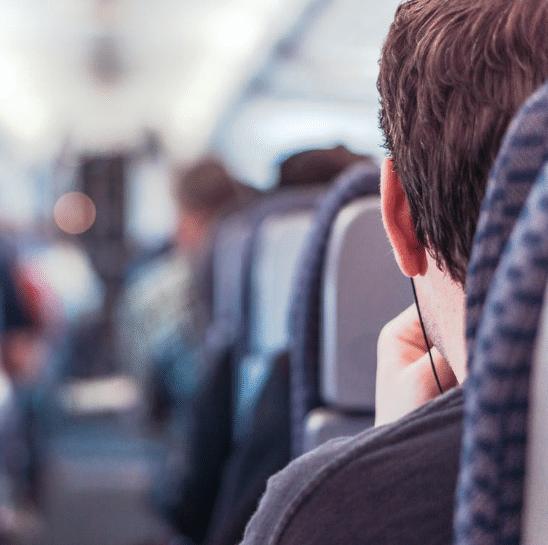
Luckily, I have not developed COVID-like symptoms two weeks after returning from my trip. Based on CDC guidelines interviews with doctors, the risk of infection can be managed without inflicting too much unnecessary trouble for ourselves.
Granted, there are factors that are out of our own control, such as flight occupancy and seat assignment {unless seat selection is allowed. But studies have shown that window seat passengers are less likely to be exposed to the activities of other people on a plane}. However, there are other easy measures to take to lower the risk of getting infected while flying, and in fact, we have been practicing many of them at home for months. Before the trip, I also consulted Dr. George Liakeas, a primary care doctor based in New York City and medical director at Lexington Medical Associate, and he mentioned the following safety protocols to follow:
Wear Masks
In a widely read New Yorker article, a renowned Boston doctor argued that both surgical and cloth masks significantly reduce the risk of virus transmission, especially if a large proportion of a crowd or, even better, all of them, have their faces covered.
To be even safer, the author also recommends wearing N95 respirators, if available, for high-exposure situations. These masks fit tightly around the nose and mouth, and the filter material can potentially block 95%of airborne particles, including the COVID-19 virus. So compared to surgical masks or cloth masks, they offer even more protection to the wearer as well as to other passengers. Don’t worry even if you can’t get hold of an N95 respirator, here is a pretty ingenious home technique using three rubber bands to create a seal over the mouth and nose. Also, doctors have suggested keeping the mask on for as long as possible during the flight, and avoid taking masks off at the same time as other passengers {for example, try to eat or drink at different times}.
Use Hand Sanitizer and Wipes
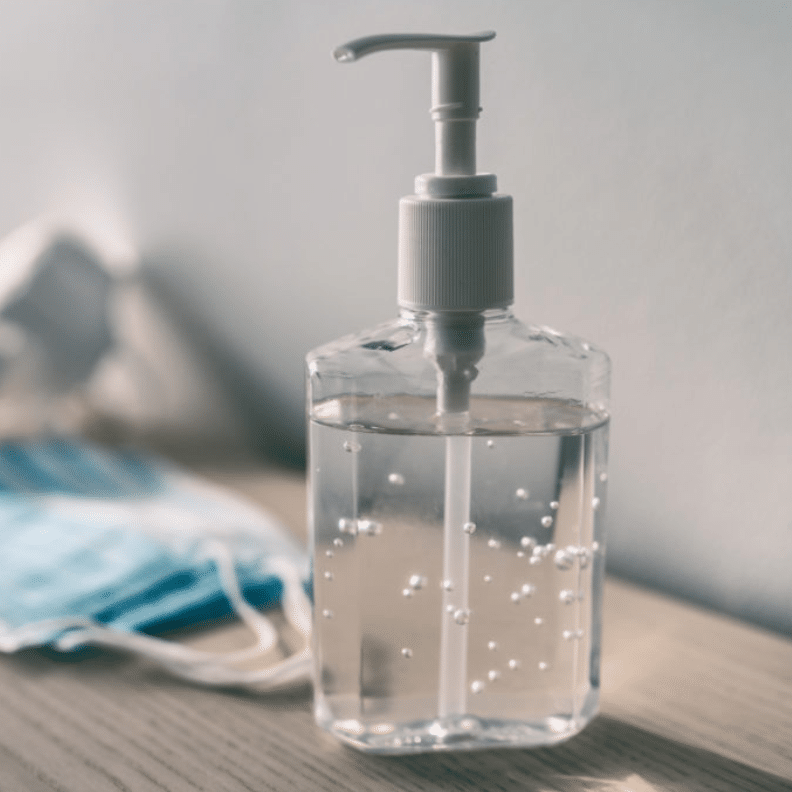
It’s just like what we do at home. ”Bring sanitizing wipes with you to clean frequently touched areas, Dr. Liakeas said. Some high-touch areas on a plane include lavatory doors and faucets, magazine bags, and tray tables, and travelers should stay aware if they touch these areas.
Read More: Daily Coronavirus Tracker for Hoboken + Jersey City
Don’t Touch Your Face
“Avoid touching mouth and nose,” Dr. Liakeas says. Studies have shown that the human nose, mouth, and even eyes are susceptible to COVID-19 virus transmissions. And doctors suggest avoiding touching them, in all circumstances, even when they get itchy.
What to Do If Someone Nearby Starts Coughing
Inform a flight attendant and request to be seated in a different area, if possible. Although this can be tricky on a full flight, it is still worth notifying a flight crew member and asking for help. Some airlines have designated areas for travelers with COVID-19 symptoms, such as fever or coughing, especially for international routes. Check with the airline to find out.
Flying can be stressful, as everything is during a pandemic. But, after living under the threat of the virus, we have learned that at the very least, risks can be managed or even prevented. So there’s no need to stress out —life will go on and so will traveling, even during a pandemic.

Check out Hoboken Girl’s new Job Board here!

